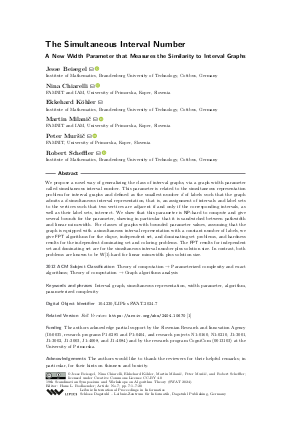LIPIcs.SWAT.2024.7.pdf
- Filesize: 0.81 MB
- 20 pages

 Creative Commons Attribution 4.0 International license
Creative Commons Attribution 4.0 International license

We propose a novel way of generalizing the class of interval graphs, via a graph width parameter called simultaneous interval number. This parameter is related to the simultaneous representation problem for interval graphs and defined as the smallest number d of labels such that the graph admits a d-simultaneous interval representation, that is, an assignment of intervals and label sets to the vertices such that two vertices are adjacent if and only if the corresponding intervals, as well as their label sets, intersect. We show that this parameter is NP-hard to compute and give several bounds for the parameter, showing in particular that it is sandwiched between pathwidth and linear mim-width. For classes of graphs with bounded parameter values, assuming that the graph is equipped with a simultaneous interval representation with a constant number of labels, we give FPT algorithms for the clique, independent set, and dominating set problems, and hardness results for the independent dominating set and coloring problems. The FPT results for independent set and dominating set are for the simultaneous interval number plus solution size. In contrast, both problems are known to be 𝖶[1]-hard for linear mim-width plus solution size.



Feedback for Dagstuhl Publishing